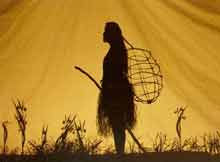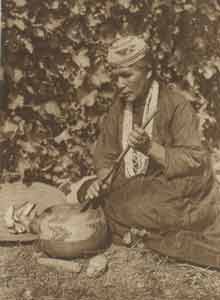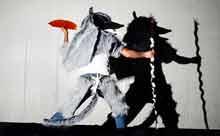
Karok (karuk, 'upstream'; they have no name for themselves other than that for 'men' or 'people', arar, whence Arra-arra, Ara-ara, etc.). The name by which the Indians of the Quoratean family have, as a tribe, been generally called. They lived on Klamath river from Redcap creek to Indian creek, north west California. Below them on the river were the Yurok, above them the Shasta, to their east were other Shasta tribes, while on the west they were separated by a spur of the Siskiyou mountains from the Yurok and the Athapascan Tolowa. Salmon river, a tributary of the Klamath, was not Karok territory except for about 5 miles from its mouth,-but was held mainly by Shastan tribes. While the Karok language is fundamentally different front the languages of the adjacent Hupa and Yurok, the Karok people closely resemble these two tribes in mode of life and culture, and any description given of the latter will apply to the Karok. They differ from the Yurok principally in two points: One, that owing to the absence of redwood they do not make canoes but buy them from the Yurok; the other, that they celebrate a series of annual ceremonies called "making the world," which are held at Panamenik, Katimin, and Inam, with a similar observance at Amaikiara, while the Yurok possess no strictly analogous performances.
The
Karok (or Karuk) live on the Orleans Karok Reservation
and the Quartz Valley Rancheria. (Eargle: 1986)
The Karok gave the Shasta tobacco seeds, baskets, dentalia,
salt, seaweed, tan oak acorns, canoes, pepperwood, abalone
shells and ornaments and olivella shells. They got juniper
beads, basketry caps, salt, dentalia, white deer skins,
woodpecker scalps, whole Olivella shells, large obsidian
blades, obsidian, deer skins, sugar pine nuts, wolf skins
and horn for spoons. From the Wailaki they got dentalia.
They gave the Tolowa soaproot and pine nut beads, and they
got smelt and dentalia. They gave the Konomihu dentalia and
baskets, and they got furs and deer-skin clothing. They gave
the Yurok dentalia and got from them whole Olivella Shells,
tobacco seeds, dugout canoes, clam shells, pipes and bows.
They got whole clam shells from the Coast Yuki, and salt
from the Nongatl.(Davis: 1966)

Coyote
Steals Fire
Devil
Who Died Laughing
Efforts
Under Way to Preserve Karuk Language
Fable
of the Animals
Fire Race

Greed,
Pollution and Genocide
Karuk
Baskets
Karok
houses at Soames Bar
Karuk
Acorn Soup Cooking Basket
Karuk
Constitution
Karuk, The People of the Klamath
Karuk
Dance Cap
Karuk
Elder Keeps Culture Live Through Coyote's Tales

Karuk
Language Resources
Karuk Tribe of California
Redistributing
the Wealth
Traditional
Karuk Dress (Photo Gallery)
Traditional
Karuk Songs
Many, many years ago there was a GOD named Eel-with -a-Swollen-Belly, who grew up at the downstream end of the world in the earliest days when the world was new. His mother lived at the upriver edge of the world. One day Eel decided that he wanted to return home to visit his mother. The path to his mother's home took him along the river bed. As he traveled upstream he overturned rocks and piled them into shrines. At each one of these places where he put a shrine he knew that humans would eventually appear. "When the people appear these shrines will help them remember that I was here. And they will place a rock on the shrine to honor me."
Eel traveled further up the Klamath River until he reached "The Center of the World". When he reached this special place he decided to create a different shrine. He made two shrines, one on each side of the river. He said to himself," The Center of the World will be filled with many people. They will need extra shrines to help them remember me." Eel traveled on the way for many days; placing shrines along the Klamath River. The river flowed downriver from the beginning of the Klamanth River. One day Eel arrived at the "Inaam World Renewal Site". After placing a shrine at Inaam he traveled further upstream . After many days he reach the upriver end of the world and his mother's birthplace. After reaching his final destination he turned into the lamprey eel that we know today. Eel was once a man long ago. And that is how Eel-with-a-swollen -belly turned into lamprey eel a long, long time ago.